
<< Back | Home | Site Map
If "Zig-Zag" is taken to mean the ascent or descent of height by means of a system of points and reverse movements in order to continue in the same direction, but at a lower (or higher) level, then Mildura can lay claim to having had such a facility.
Mildura's "Zig-Zag" came into being when it was decided to connect Mildura railway yards with the banks of the Murray River. The Railway Construction Branch constructed a line on a downgrade to the Murray River frontage to enable the provision of a siding to facilitate the unloading of stone and gravel railed from Carisbrook, near Maryborough, for the South Australian Government's construction of Lock 9, Kulnine, between Mildura and Renmark on the Murray River. This material was then to be shipped down river by barges. Survey work commenced in July 1922 and the construction of the line was completed by January 1923.
Mildura station yard is elevated on an embankment overlooking the river and a steep downgrade line was necessary to gain access to the riverbank. A short dead end siding extended off the line at the foot of the downgrade as a safety catch siding, the points being normally set for the siding to direct any runaway vehicles off the falling grade. It was also used as a head shunt for the South Australian government Gravel siding, leading in the reverse direction from the Construction siding to a point downstream. The siding was required for the transfer of gravel railed from Carisbrook. The gravel was transferred into river barges for use in the construction of Lock No. 9 on the Murray River by the South Australian government. As the Gravel siding required a set of reverse points the "zig-zag" feature was created. A loop for standing vehicles was provided on the river side of the siding. The siding was commissioned on 9-1-1923 and was dismantled in 1928.
A cattle pit was installed where the rails crossed Cureton Avenue (now Hugh King Drive) in July 1923 and the Construction siding, sleeper siding or wharf siding, as it was variously described, was in use by the end of the month.
Construction of a siding for the State Rivers & Water Supply Commission to serve the construction of Lock No.11, commenced in November 1923 and was available for use from 16-4-1924. It branched off the Construction siding and had a loop 450 feet long for standing vehicles before extending some distance to the Lock site. It traversed a line cut into the cliff below the Mildura Bowling Club and curved on an embankment across the flood plain to the lock site. This embankment can still be determined even though the railway line was dismantled in 1928.
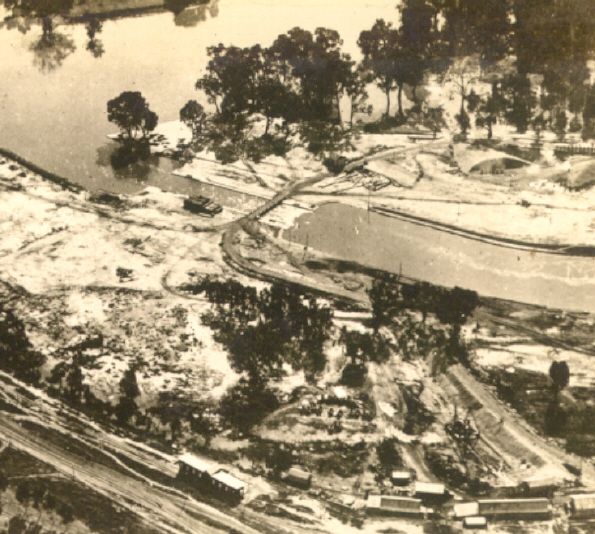
Construction of Lock 11 at Mildura. The railway siding to the lock site traversed the embankment at lower right. Circa 1923. Photo: Bruce McLean Collection
Gravel from Duke and Main Leads Gold Mine Co. at Bet Bet, near Maryborough, was purchased by the SR&WSC for the construction of the weir and lock chamber. With the completion of the project, the line was dismantled, a short section being retained below Mildura station yard for the unloading of firewood for Mildura Shire Council.
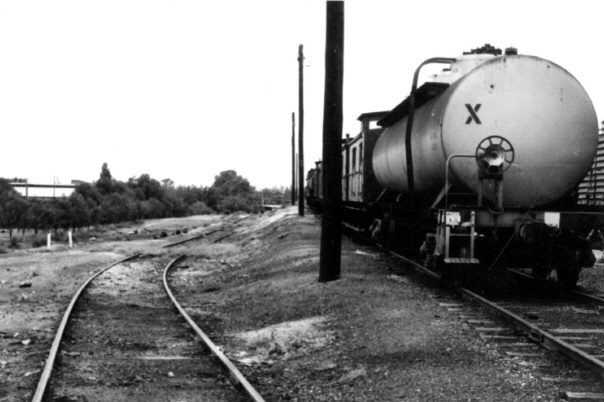
The downgrade line from the station yard showing the start of the long descent to the river front sidings. April 1973. Photo: Bruce McLean
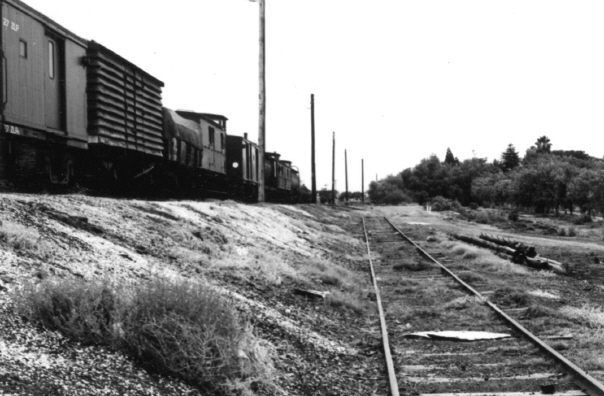
Downgrade line from Mildura yards to the riverfront. This view is looking up the grade to the Mildura station yard. April 1973. Photo: Bruce McLean
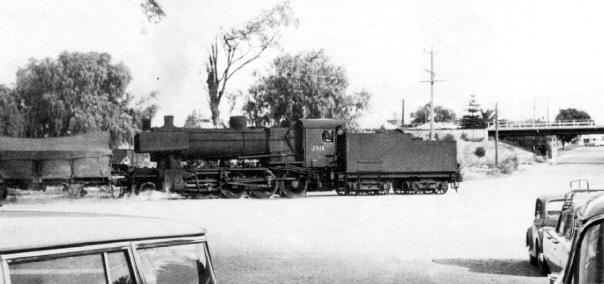
J516 shunting the Mildura wharf siding. The main line to Melbourne crosses the Madden Avenue bridge in the background. The cattle yards siding, built in 1950, passes under the pepper trees behind the locomotive, extending to the left. Date unknown. Photo: Reg Phillips
In October 1923 work commenced on the construction of Lock 11 at Mildura and a branch line was built from the South Australian Government siding, behind the powerhouse, past the rear of the present bowling greens, across a low embankment and into the lock site. From the end of this line, 2 foot gauge tramways radiated around the worksite for the dispersement of materials. Gravel, stone and other construction materials were despatched daily from Mildura station.
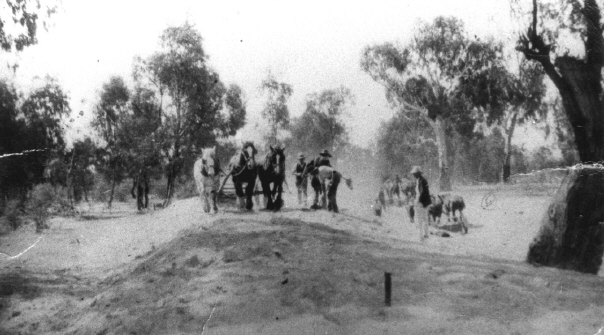
Mr. D. McKay's horse team constructing the branch line to the site of Lock 11 at Mildura in 1922 for the South Australian government. Photo: D. McKay from Bruce McLean Collection

In April 1973 the sleepers from the set of points leading to the South Australian government's siding to Lock 11 were still in place. The points to the siding were located opposite the Mildura Rowing Club building. Photo: Bruce McLean
After completion of the river projects, the South Australian Government riverbank and Lock 11 sidings lay idle until dismantled during the mid-1930's. By 30-5-1939 a siding was connected to the Mildura Powerhouse in the vicinity of the South Australian Government siding, for the receival of briquettes. The location of this siding was altered slightly after 1952.
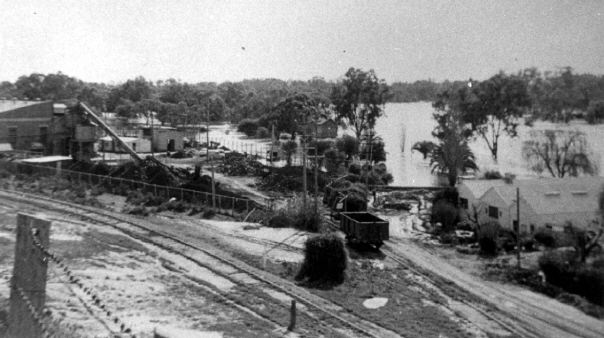
The Murray River was in a record flood in 1956 when this view of the power station siding was taken from the overhead bridge leading to Mildura goods yard. The Rowing Club sheds are to the right and the downgrade line from the yards to the riverfront is in the foreground. Photo: Joan Lee

Sleepers remaining where points were removed after the dismantling of the old Mildura powerhouse siding provide evidence of the bottom points that formed the "zig-zag" feature on Mildura's riverfront railways. April 1973. Photo: Bruce McLean
In 1947 it was decided to remove the Mildura stock yards from near the carriage sheds in the station yard to a new site on a branch line to be built off the wharf siding. After some delay, the siding and stock yards were completed in June 1950. These stock yards were the cause of considerable agitation in 1972 when Mildura City Council urged their removal, along with the wharf siding, so that a program of riverfront beautification could be implemented.
The Mildura City Council met with the Chairman of the Victorian Railways Commissioners on 29-10-1963 and put forward a number of initiatives that had a direct impact on railway infrastructure including a request for elimination of the section of line owned by the railways leading to the Mildura Powerhouse and removal of the former sawmills line.
The Chairman of Commissioners responded by saying that they would not remove the wharf and sawmill railway line for riverfront beautification. If the line was transferred to another area the cost would have to be paid by Council but when he asked if Council was prepared to pay there was no response. A similar agenda awaited the Commissioners when they returned a year later on 24-11-1964. This time the Chairman indicated that he would be happy to keep in mind and discuss with councillors any proposals to shift the railway yards "just as long as there were no commitments". Mr. Brownbill also retained his stance on removal of riverfront railway lines for beautification purposes. The only concession from the Chairman was approval for removal of the section of the siding into the old Mildura City Council Electric Supply Department powerhouse (transferred to the State Electricity Commission in 1952 and now known as S.E.C. Siding) from the points to the gates of the powerhouse, on 14-1-1965.
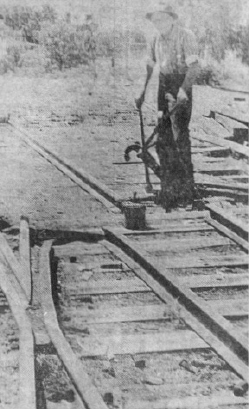
Press cutting from "Sunraysia Daily" showing a railway worker dismantling the section of the former Mildura Powerhouse (later State Electricity Commission) siding at Mildura on 14-1-1965. Source: Bruce McLean Collection
The siding was dismantled in August 1965 when the power station was rendered redundant with Mildura's connection to the State power grid. The removal of the powerhouse siding effectively eliminated the "zig- zag" aspect of Mildura's riverfront railways.

Map showing the network of sidings that were located at various times on the Murray River frontage at Mildura including the "zig-zag" feature. Map: Australian Railway Historical Society Bulletin No.484, February 1978.
Following a State Government grant of $51,000 to pay for the cost of removal of the riverfront railways, new stock yards and associated sidings were constructed off the main line between Mildura and Irymple. The wharf siding was spiked closed on 21-3-1973 and the stock yards closed on 7-9-1973 when the first stock were loaded at the new yards and despatched by the "Fruit Flier" express goods.
During the first week of September 1973, the wharf siding was dismantled and the rails recovered were temporarily relaid on the site of the powerhouse siding in order to move steam locomotive K175 which had been acquired for preservation by Mildura Jaycees and presented to the City of Mildura for preservation in a park established in the former power house grounds. In the second week of September, K175 was moved along the temporary track in stages, being hauled by a City Council earth-moving machine.
After K175 was placed in position, workmen commenced dismantling the remaining portions of the riverfront railways and began the construction of new roadways and gardens.
A section of the downgrade track from the railway yards was left for the storage of rolling stock and a baulk was placed across the end of this line on September 12, 1973.
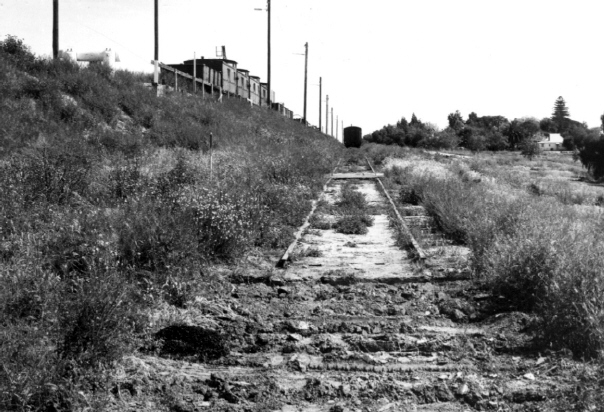
The remaining portion of the downgrade line as seen on 17-9-1973. A baulk was placed across the rails to stop any wayward wagons rolling off the end of the line. Photo: Bruce McLean
Subsequent roadway construction and landscaping of the riverfront area has now obliterated any sign of the small network of railway lines that once served Mildura's riverfront and utilised the unique facility of a "zig-zag".
| << Back | Home | Site Map | Copyright © 2003 Bruce McLean, All Rights Reserved |